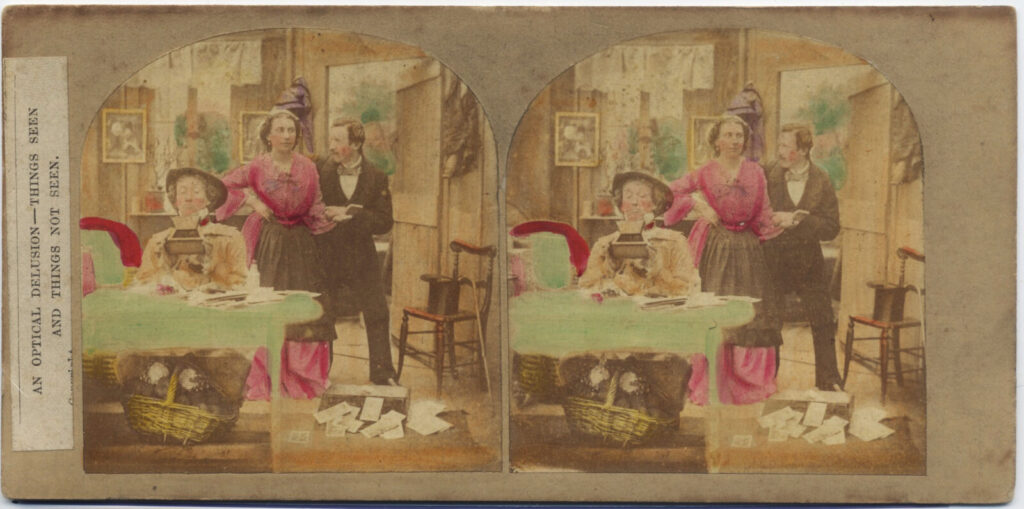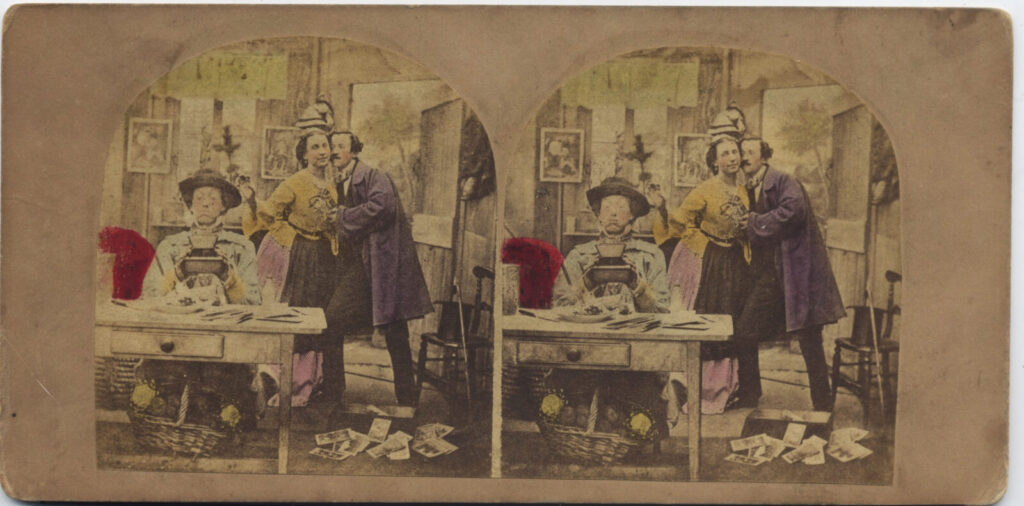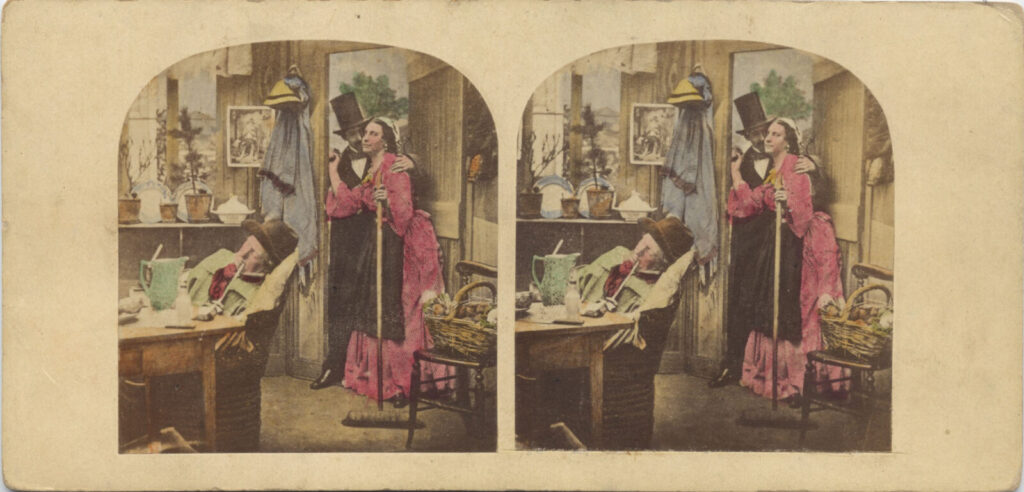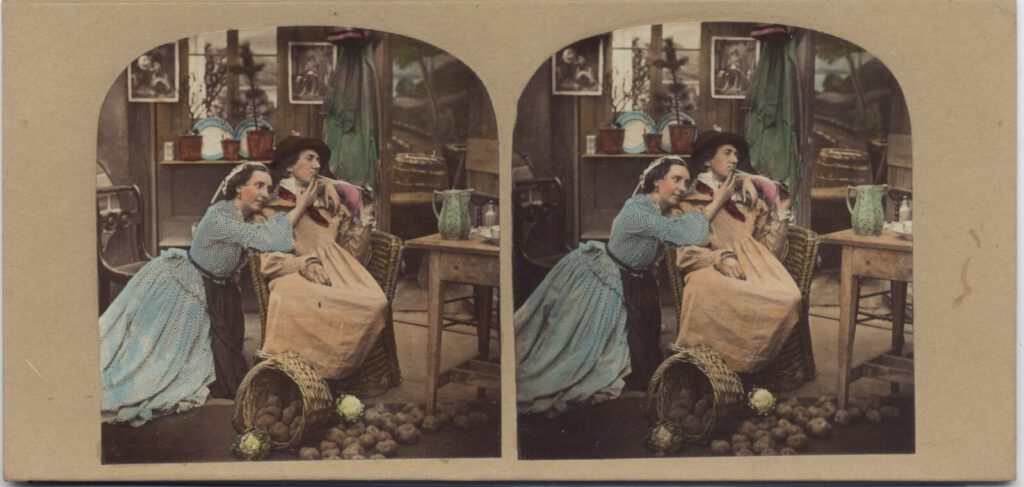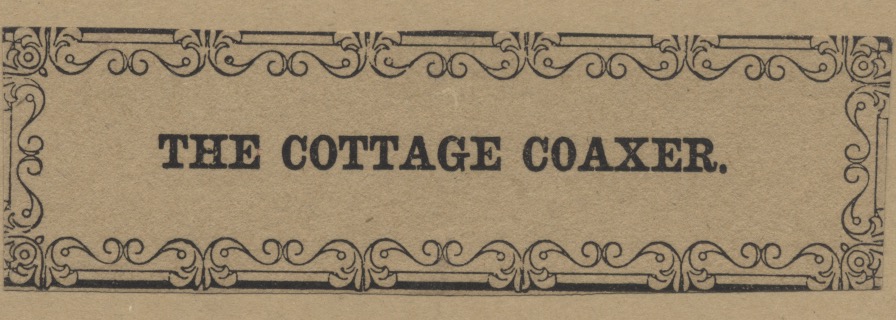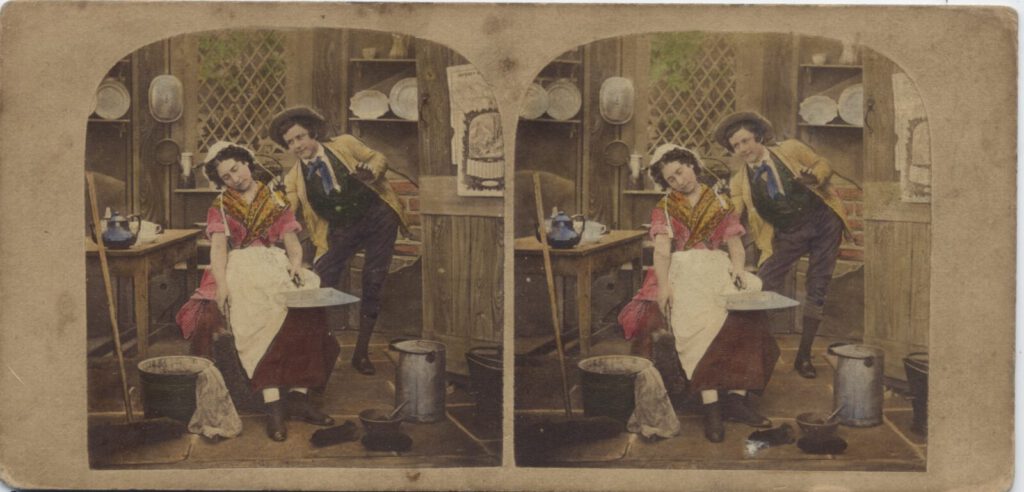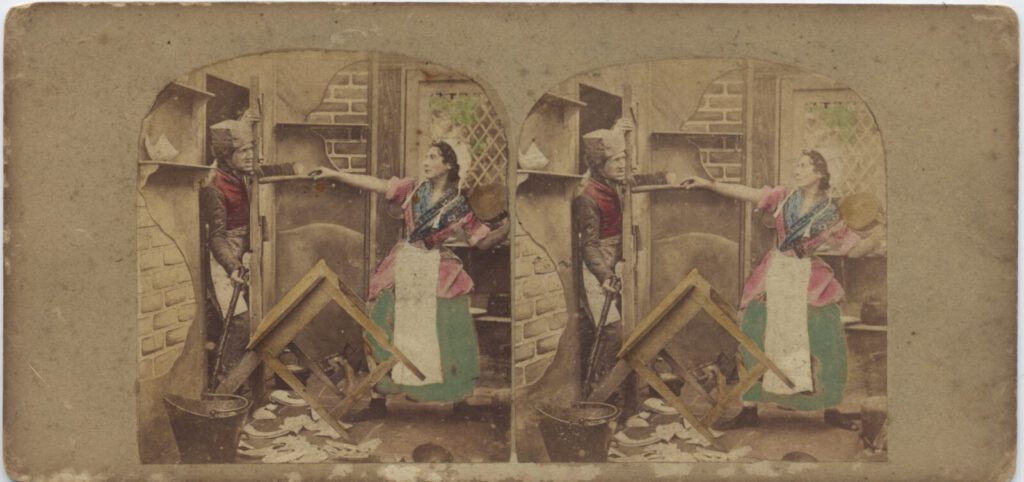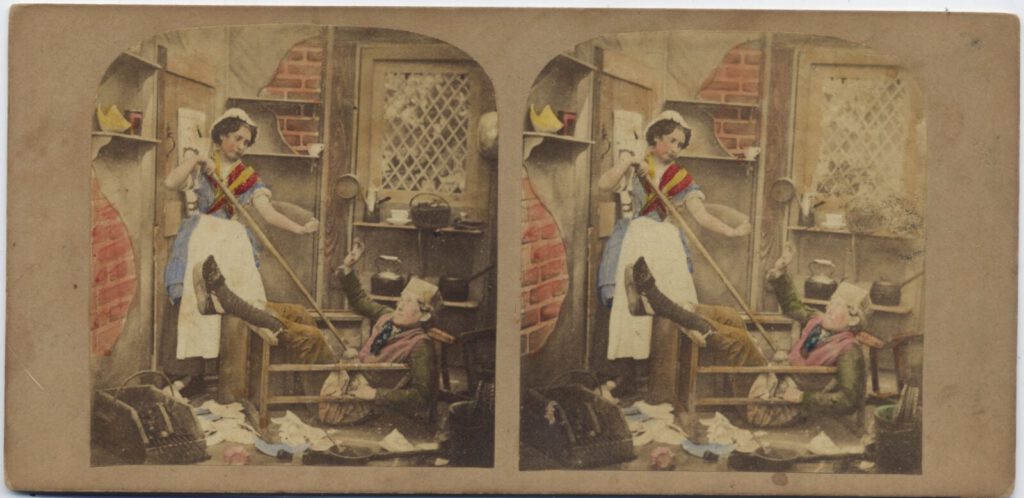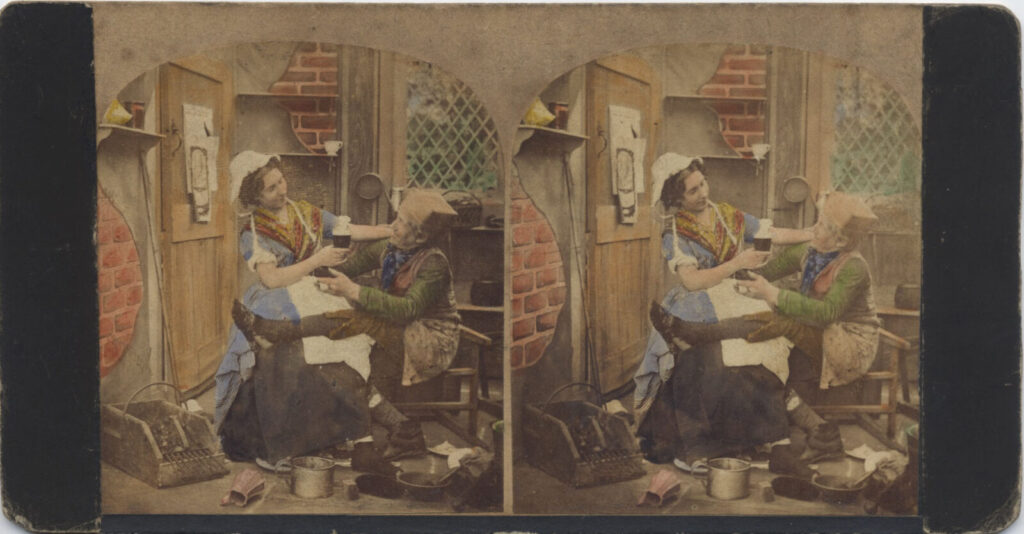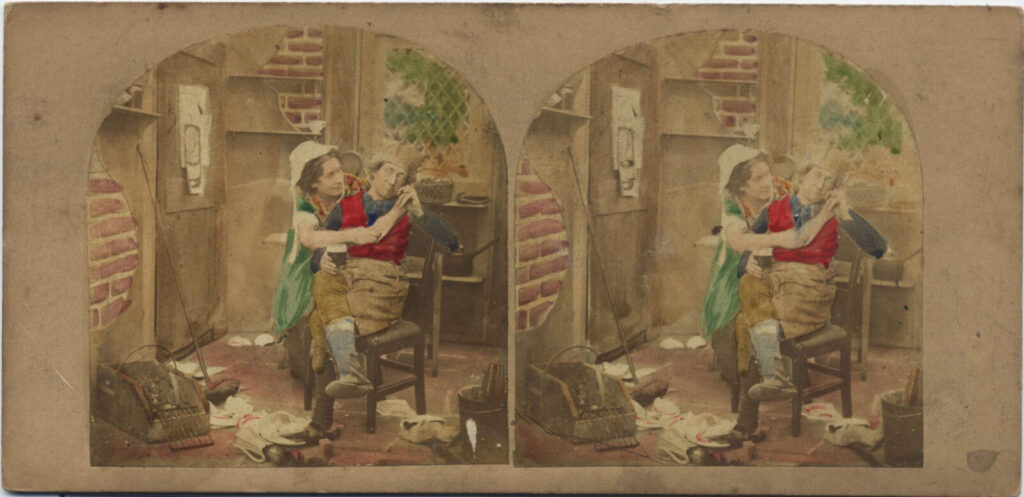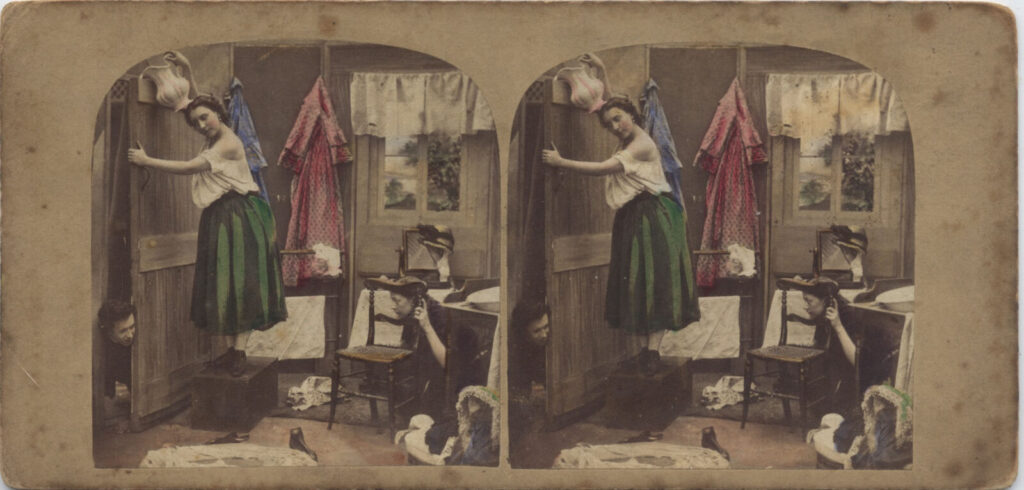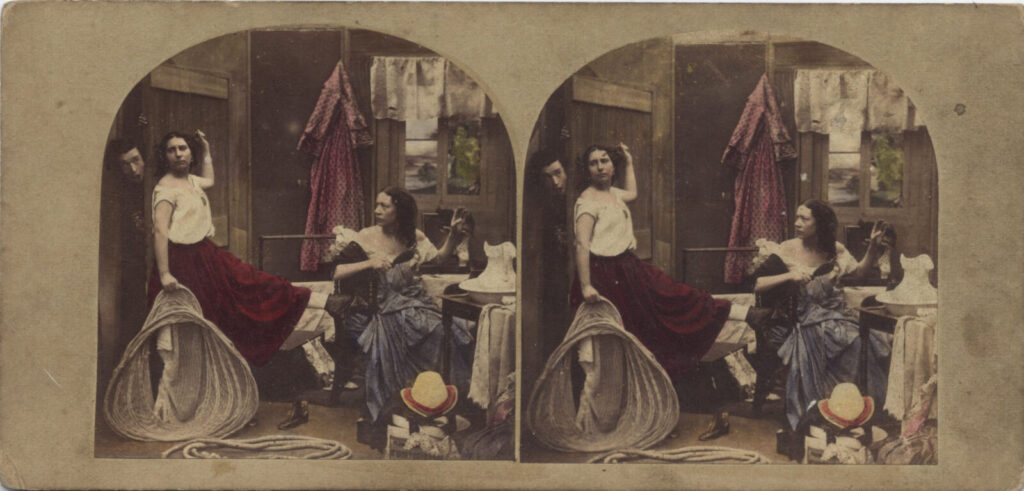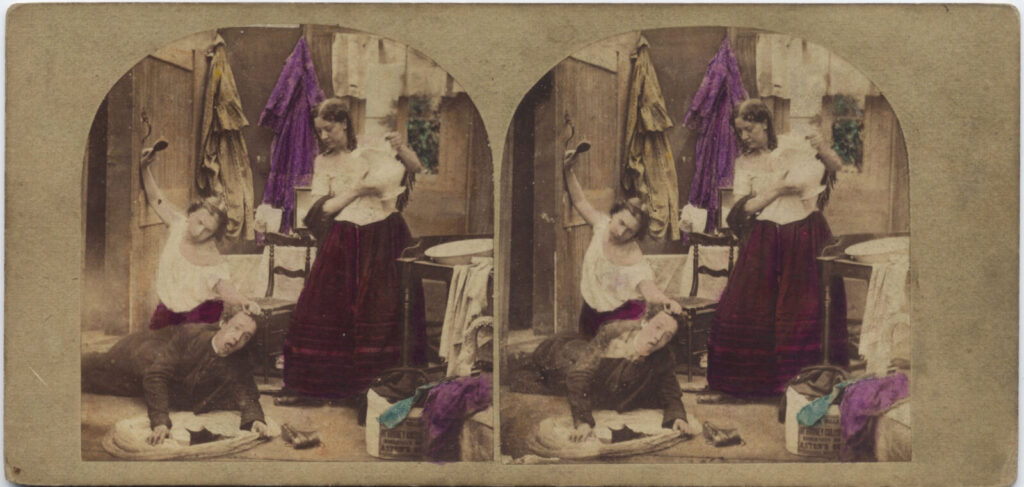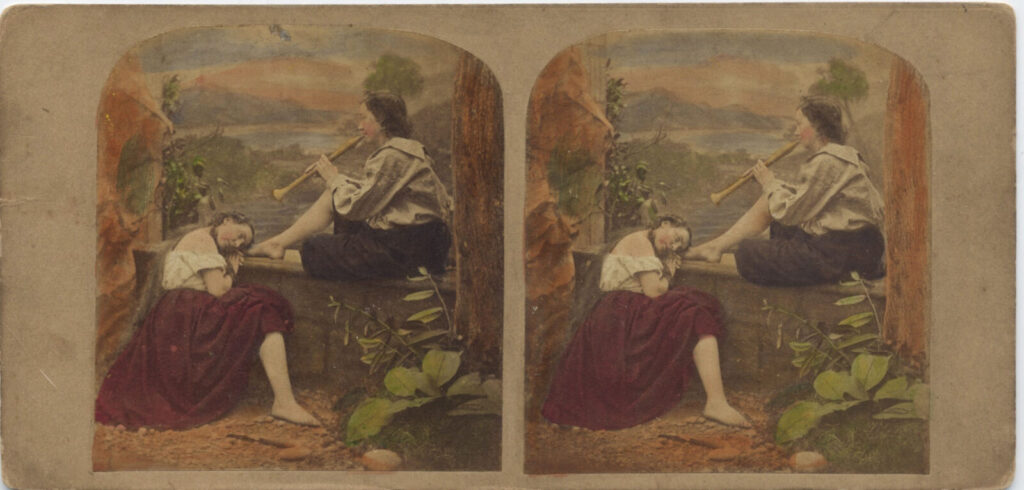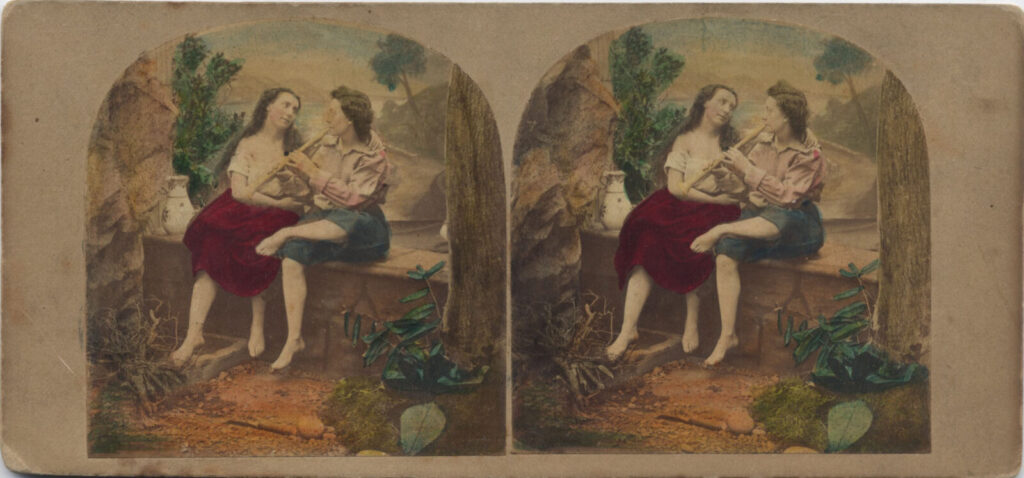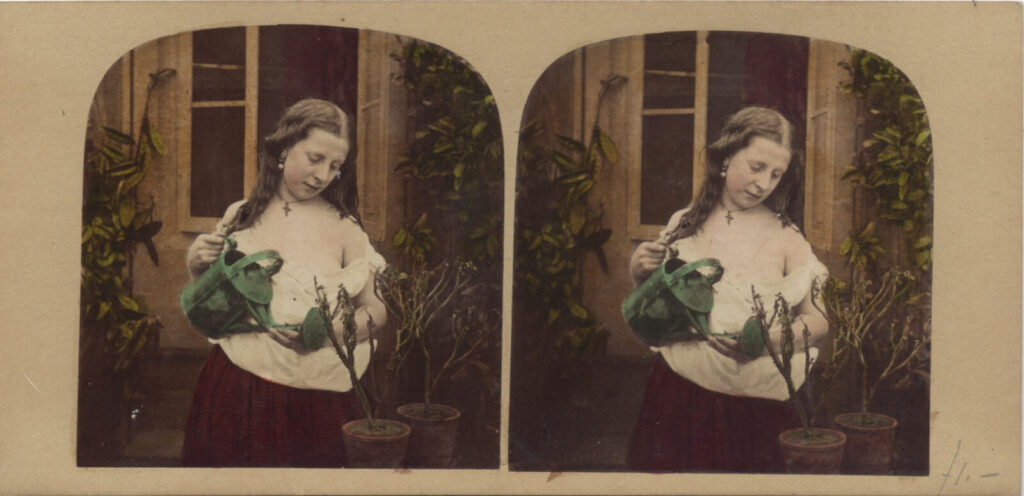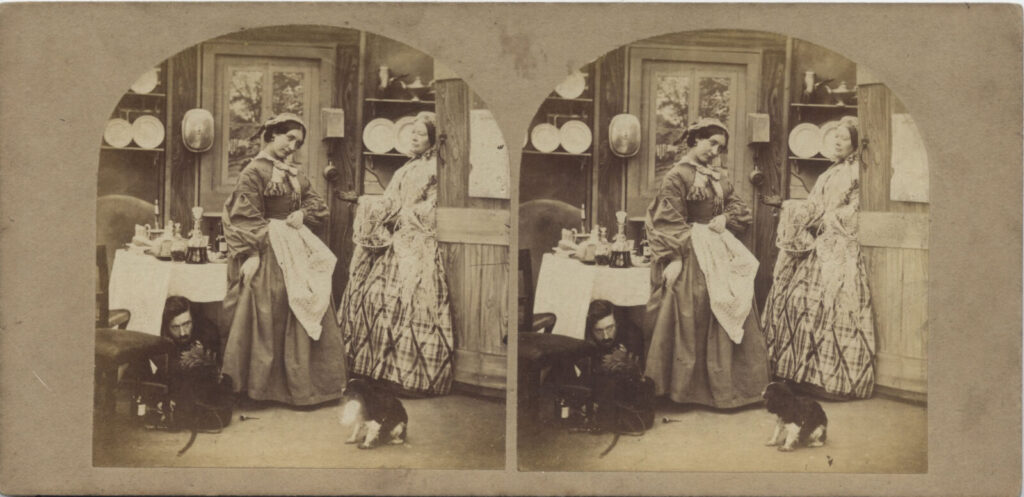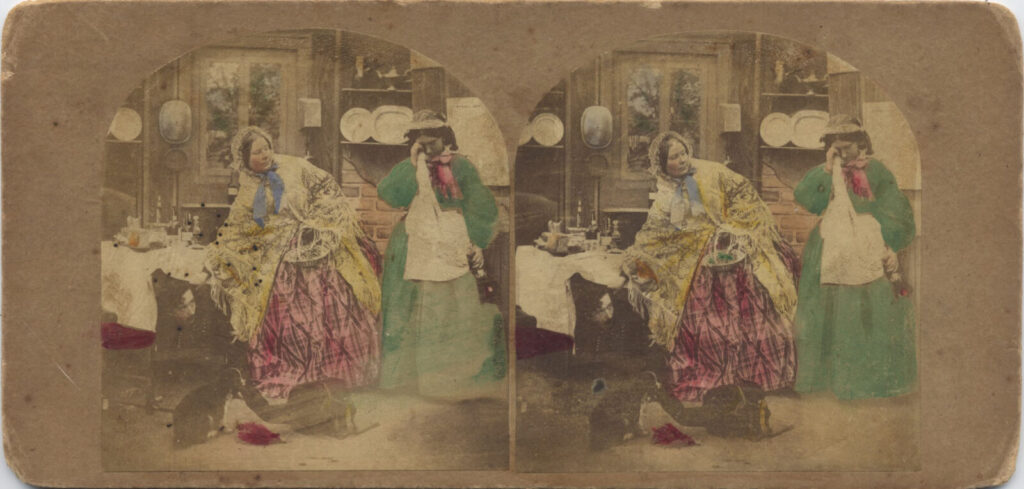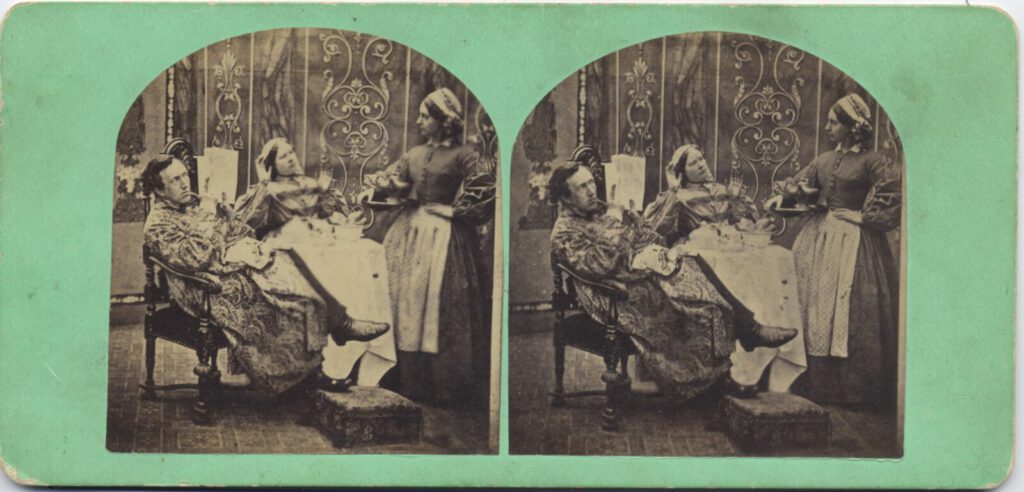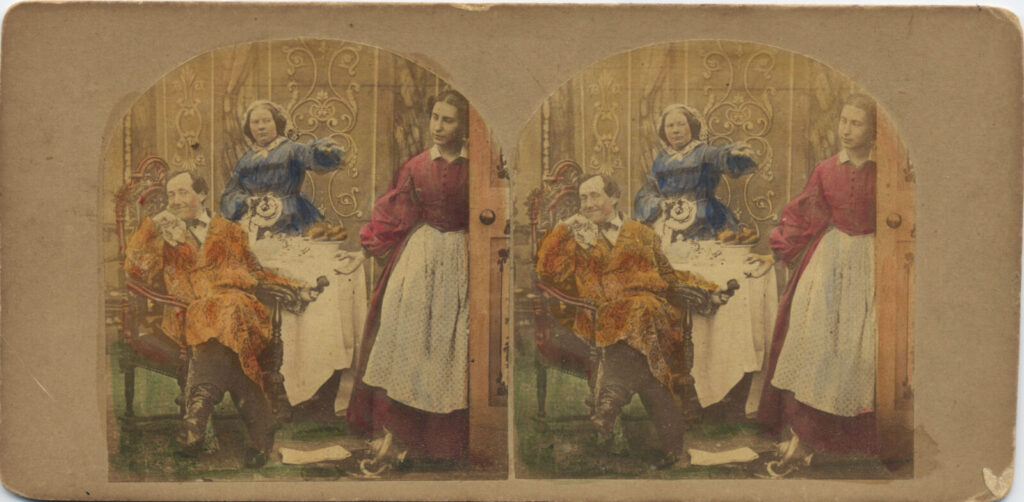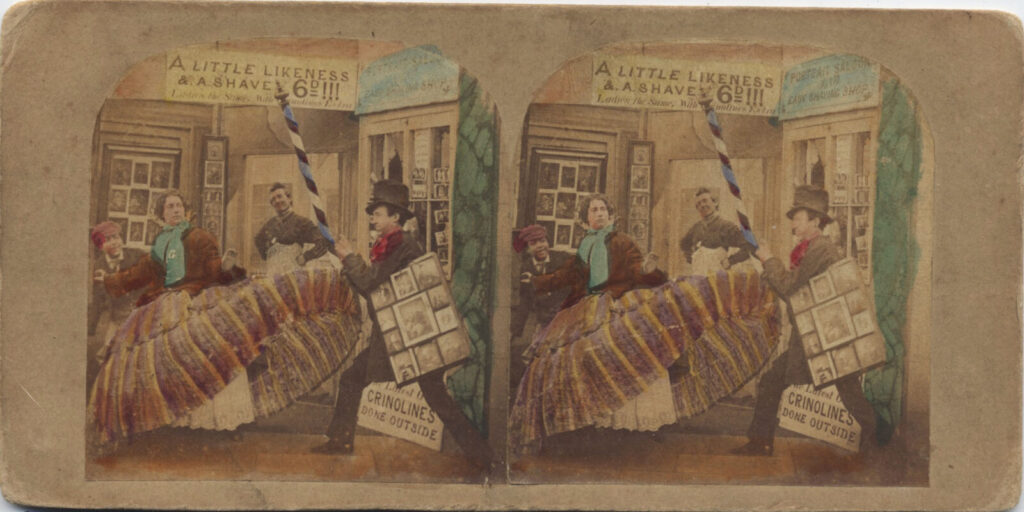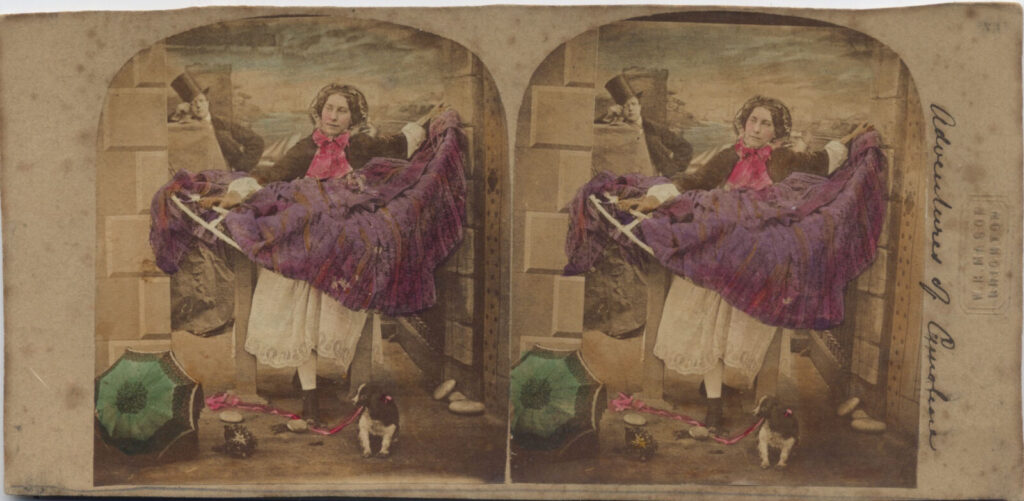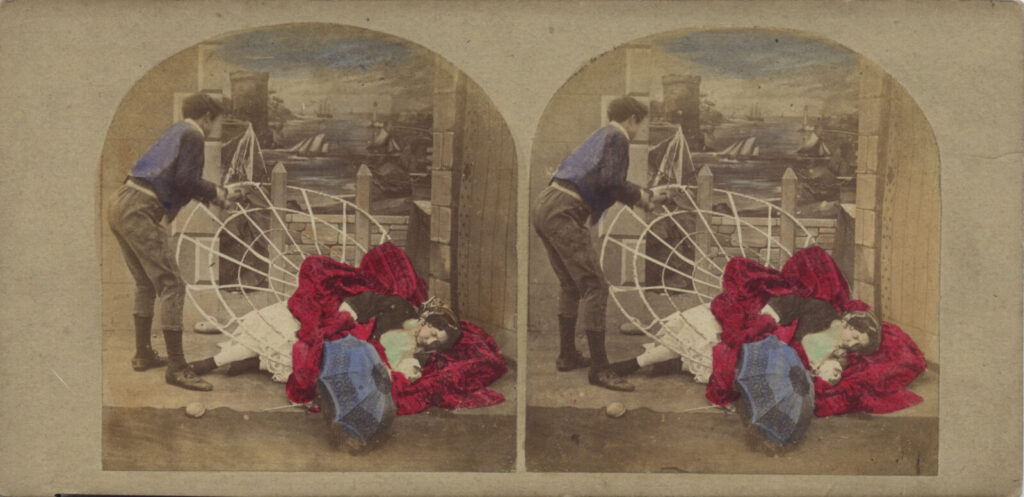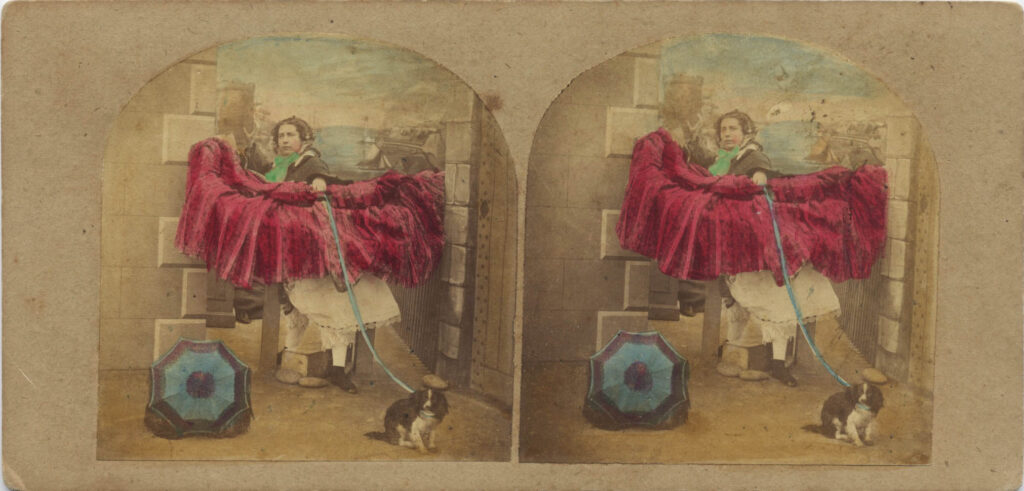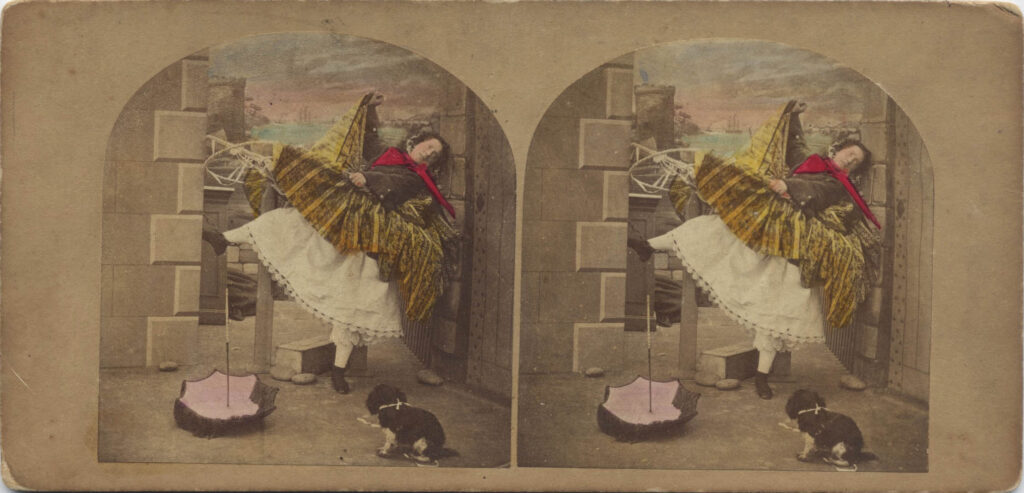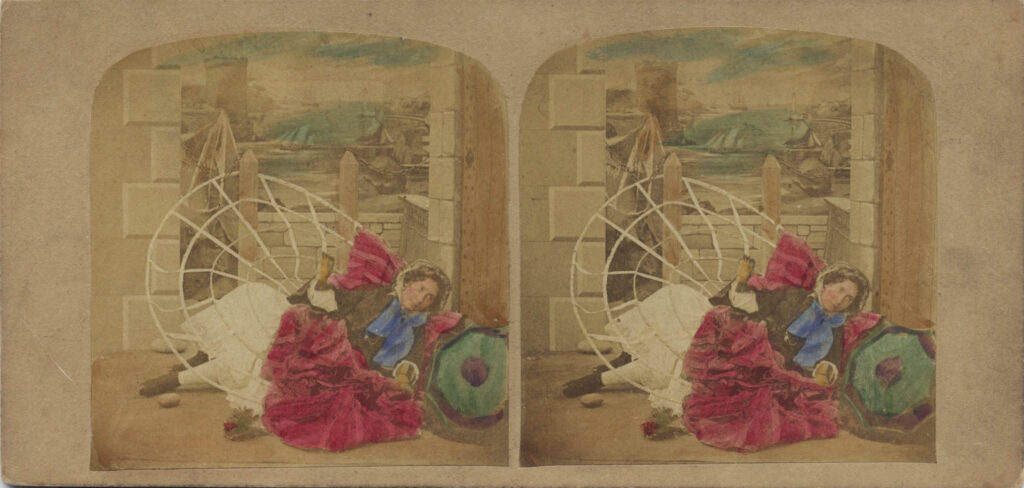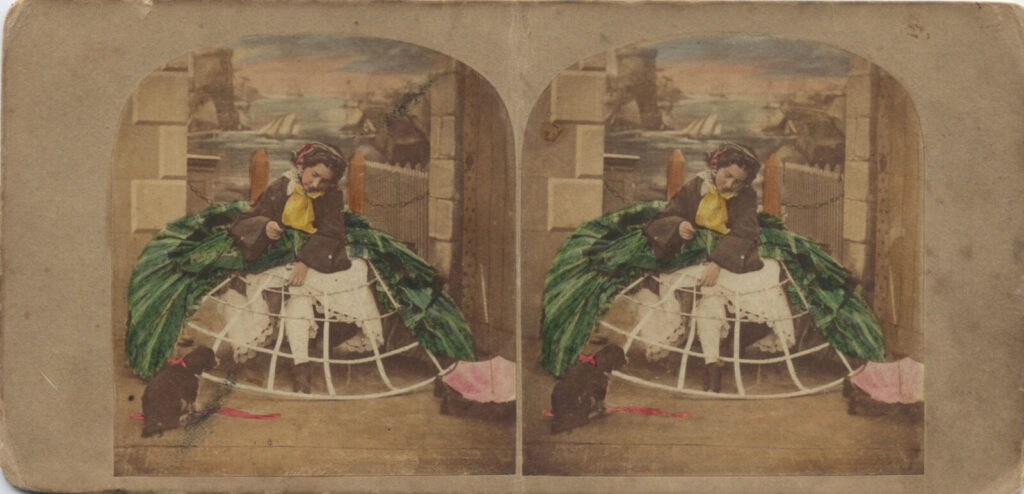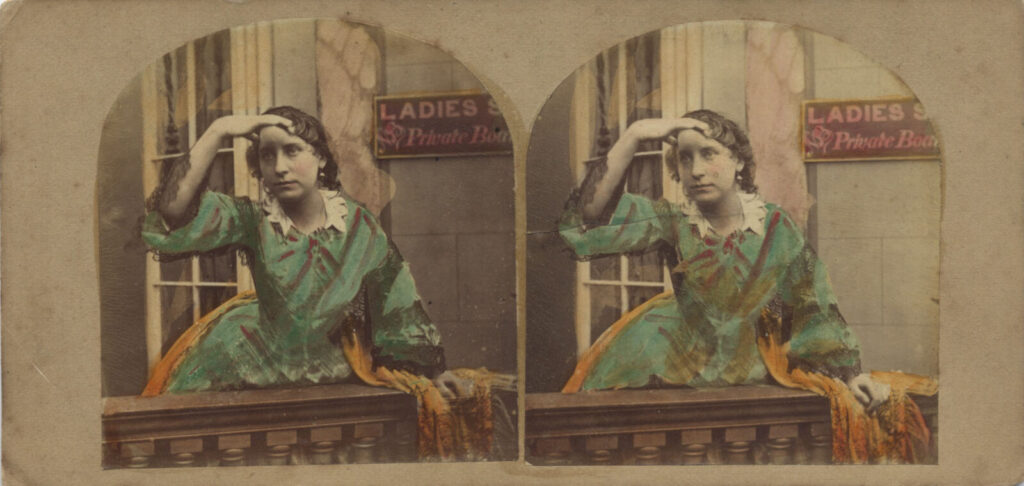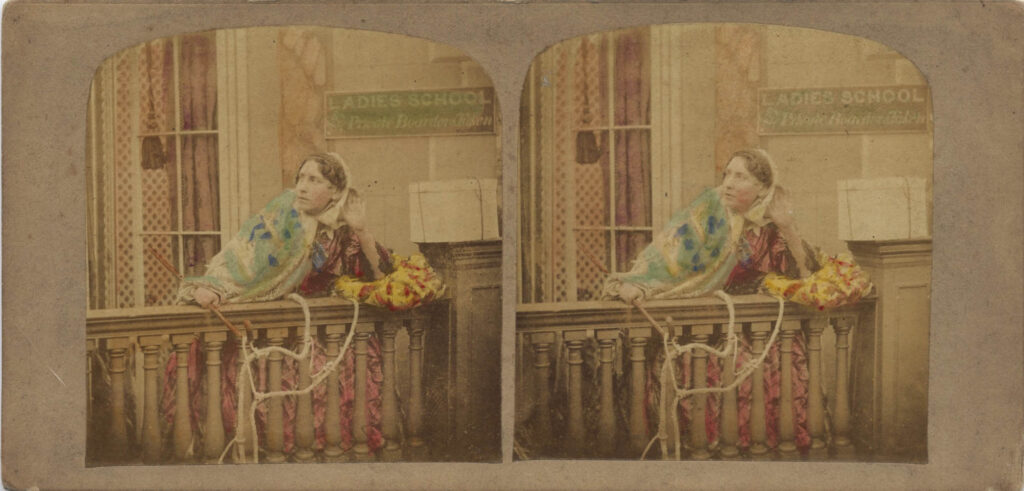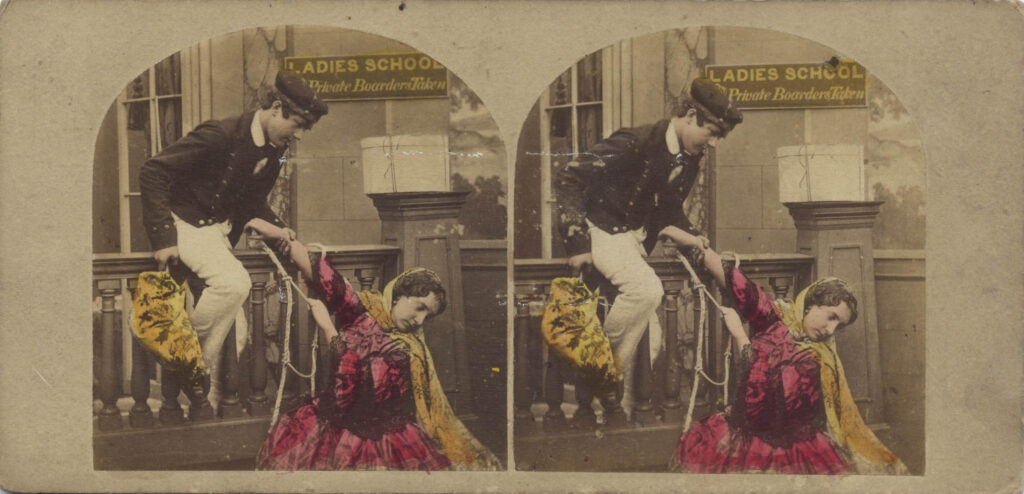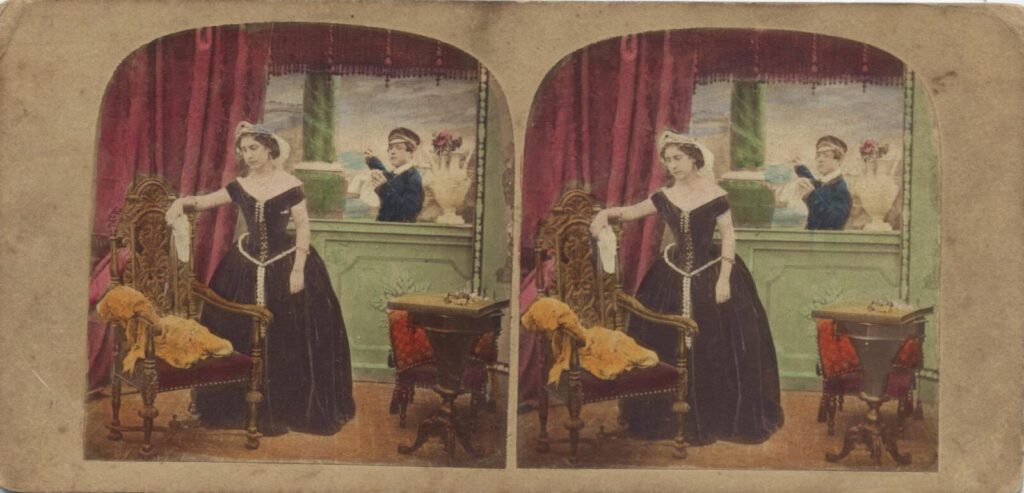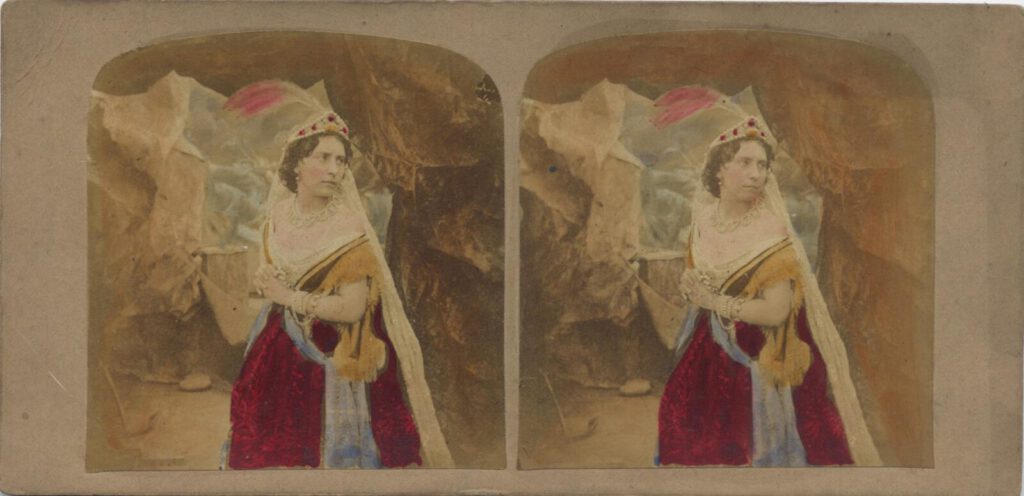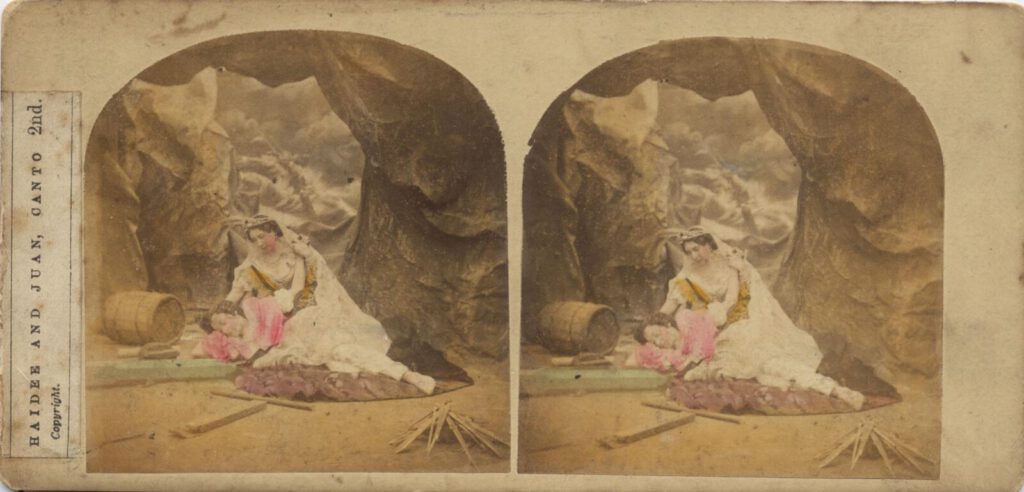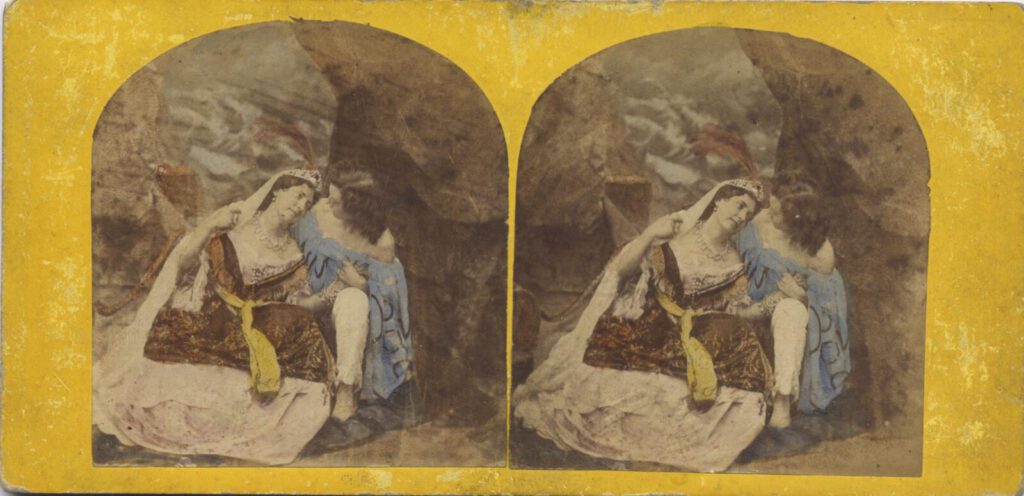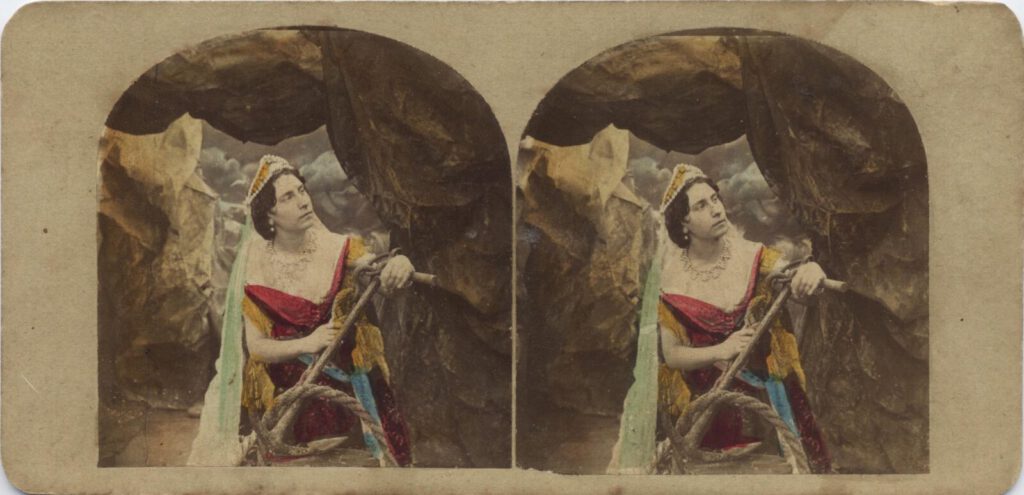Michael Burr’s Favourite Model
written for the stereosite by Jonathan Ross, UK
Michael Burr was one of the most prolific photographers of staged genre stereoviews in the Victorian era. Following in the footsteps of masters like James Elliott and Alfred Silvester and frequently adapting the themes of other popular photographers, this Birmingham based entrepreneur created a catalogue estimated at over 1,000 images during a period from 1862 to the mid 1870s and evidently sold his work in large quantities as there are so many of his stereoviews still surviving.
Like most photographers Burr had his favourite models who make regular appearances in his tableaux, and in the 300 or so of his works in my collection I have identified one who appears over 40 times. Many of the models in genre photography have the appearance of character actors and it would be interesting to find out if any had successful careers on the stage, turning to modelling work when they were ‘resting’. We know that photographers like C.E.Goodman and Martin Laroche photographed actors from current theatre productions and many genre scenes look like stage sets though they were actually constructed in photographers’ studios for the sole purpose of creating stereoviews. However the identity of most of the actors/models in genre scenes remains unknown so I do not have a name to give to the actress who will be the main protagonist of this story. She will just be Our Heroine.
One of her best known roles, and perhaps the most relevant to readers of this article, is as the wife of a stereograph enthusiast who, while her husband is occupied in scrutinising the latest offerings from the travelling stereo salesman, takes the opportunity to flirt with the top-hatted purveyor of 3D delights.
An Optical Delusion – Things seen and Things Not Seen
‘An Optical Delusion – Things seen and Things Not Seen’ card is an early example of a theme that stereoview publishers explored until the turn of the 20th century, promoting the view that travelling salesmen are generally a bad lot and not to be trusted around your womenfolk.
The first image carries a typical Burr label, a small strip pasted to one side of either the back or front of his cards with the title and, just visible here, the word Copyright or Registered. Very few of Burr’s cards have his name on them though occasionally you find one with an M.Burr blindstamp.
I first noticed Michael Burr’s name in a 2003 publication by Tex Treadwell’s Institute for Photographic Research called The English Masters of Genre Stereoviews, but Denis Pellerin and Brian May’s book The Poor Man’s Picture Gallery (which contains a short biography) and the National Stereoscopic Associations listings have opened my eyes to the extent of his output. To begin with I did not value his work as highly as some of his predecessors but it is a considerable achievement.
This variant of An Optical Delusion (an American pirate copy) shows Our Heroine getting a bit more intimate with the slimey salesman and in ‘Where Ignorance is bliss, tis folly to be Wise’ the rustic husband has dropped off in his chair while his wife bids Au Revoir to the salesman, looking like a pantomime villain in his tophat. As always, Burr’s views are filled with enjoyable details, in this case the accoutrements of a country cottage.
At this stage I should say that there is no indication of the sequence in which Burr’s images should be viewed but I have always enjoyed creating a scenario from what were often clearly variants made to maximise the productivity of a day’s work in the studio, and imagining myself behind the camera, directing the actors and rearranging the props.
‘The Cottage Coaxer’ is a case in point. We see the same rustic couple in the same cottage setting but there is no evidence of the stereo salesman’s visit, though the couple have clearly had a row about something and the wife is using her powers of seduction to restore her husband to better humour. This finely tinted copy in excellent condition has a different style of label to the one described above but one that is frequently found on cards produced by Burr and other photographers, so presumably a border that was readily available to printers.
Temptation Tries the Man
The second set of views we are looking at sees Our Heroine still in a humble cottage setting but, initially at least, in the virtuous role of a housewife, dozing in her chair after a morning’s chores. A young admirer has crept in while she slept and appears about to pull off her bonnet.
The title, ‘Temptation Tries the Man’ is set in yet another font but one that is quite familiar from other Burr views.
A second view, with the title ‘The Thief Captured’, sees her admirer at her feet with Our Heroine’s hand in his while she holds up her other hand in a gesture which seems to say, channelling Beyoncé “Put a ring on it”.
A variant of the view, on an unusual yellow mount, has the young man on his knees while Our Heroine is standing with a coy gesture but a rather pleased expression on her face. Perhaps the offer of a ring was forthcoming?
Both these last two images have labels in another style with a plain sans serif font.
Family Jars
The next three stereographs, all with the title ‘Family Jars’, which presumably means a row or what the British police call a “Domestic”, show Our Heroine in the same rather run down cottage setting, which is now in a hell of a mess, fending off a man in a carpenter’s hat with just a brush and a pair of bellows as he pokes his head through the door, an evil expression on his face and a sort of cudgel in his hand. She has the kitchen table tilted against the door to keep him out.
The man, incidentally, is played by the same actor who the travelling salesman in the first view of this story was hoping to make a cuckold of.
In the next view the man is through the door but his wife has the better of him and he is flat on his back, tangled up in the table, as she keeps him down with her broom, shaking her fist at him as if to say “Don’t try that again, Buster!” He holds up his hand submissively in admission of defeat.
In the last Family Jars variant, the couple are reconciled and Our Heroine offers her miscreant husband a glass of stout while he, with his leg up on her knee, smiles back, glad the ruction is over.
A differently titled image, of the same actors in the same setting, is ‘After a Storm cometh a Calm’, and needs no further explanation.
Curiosity Punished
‘Curiosity Punished’ is the title of the next three stereographs, showing Our Heroine and a female companion in slightly nicer surroundings – at least the plaster isn’t falling off the walls — but being pestered by a young fellow who can’t restrain the urge to get a look at the girls in their déshabille. Men tend to come off the worse in their encounters with Burr’s women and this foolish chap is about to get a soaking.
In the second variant, Our Heroine has the intruder’s head trapped in the door and he doesn’t look at all happy about it. Her booted foot is up against her friend’s chair to give her extra force and the crinoline she is holding looks like it could make a useful net to catch the fool in.
In the third variant, curiosity may not have killed the cat but it certainly got this chap a good pasting. Our Heroine is whacking him with a hairbrush with one hand while the other has a hold of his hair. Her companion is poised to tip a jug of cold water over him too. “That’ll teach you to spy on us!”
Rustic Music
‘Rustic Foot Bath’ was the name of a popular stereoview first published under the name of Phiz (the pseudonym of Alfred Silvester) c.1858 and reconstructed almost exactly by Michael Burr later, as was his wont. In Burr’s version Our Heroine rocks the same sort of off the shoulder look as in ‘Curiosity Punished’ and has the same female companion as in that series only this time her friend is en travesti, playing the role of a romantic musician, serenading his lady love. In the Phiz version both parts are also played by women but I don’t think there was any Sapphic suggestion intended, just an excuse to show some bare ladies’ legs.
In a variant of the image Our Heroine has her arm around the musician’s shoulders and is gazing at ‘him’ with an adoring look.
Burr, like other Genre photographers, was not one to waste a good set on a single image. After all quite a lot must have been invested in building the scenery, not to mention hiring the costumes and paying the actors. So in the following view, Rustic Music becomes ‘Rustic Foot Bath’ and Our Heroine strikes a rather more raunchy pose, breaking the forth wall with a Fleabag style glance at the viewer and the suggestion that it is not just her feet she is about to wash — her top might be coming off at any moment.
Our Heroine also appears déshabillé in an image entitled simply ‘Evening’ in which she poses with a watering can and some severely dehydrated pot plants.
Love Below Stairs
In the “Love Below Stairs” series we see her in the role of a domestic servant at a time when followers were not allowed. In other words if you were someone’s cook or housekeeper you were not permitted to entertain gentlemen callers. In this nice sepia stereograph called ‘The Surprise’, Our Heroine is concealing a man under the kitchen table, having heard her mistress approaching. He is hoping that the little dog does not give the game away, while she is giving us a look as if to say “Don’t breathe a word!”
In a rather grubby variant, the man is discovered and it looks as though the dog is to blame. Our Heroine knows she is in trouble.
Her mistress sends him packing though he twirls his moustache defiantly. Our Heroine’s pleas are to no avail.
Domestic Difficulties
In ‘Domestic Difficulties’ we see her Upstairs in her employers’ breakfast room, clearly involved in some kind of altercation with her mistress, while the man of the house cautions her from behind a raised newspaper. We may assume that he and she have been carrying on and perhaps she feels secure in her position? The pale green mount and the cropping of the images suggest that this is a pirated view.
In this finely tinted variant we see Our Heroine begging her master for help while he denies everything and his wife shakes her fist in rage. We can see that Wifey has snatched off her servant’s cap and is holding it in her left hand. Perhaps it was of too fine a quality for a housekeeper and may have been a gift from her master?
In the final variant of Domestic Difficulties Our Heroine is ordered out of the house, but her master is giving us a look as if to say “Oh well, it was worth it!”. He is slipping her something, which I assume is some money, and she doesn’t look too put out.
The male character is once again played by the Michael Burr regular who you may recognise as the rustic stereo enthusiast we met earlier and the beleaguered carpenter in Family Jars
What are you all looking at?
Out on the street, Our Heroine joins a crowd with her female companion from Curiosity Punished and a little black boy I recognise from other Burr views. The title of the view is ‘What are you all Looking at?’
To which the answer, according to Ray Norman from worldofstereoviews.com is Donati’s Comet. “First observed on 2 June 1858 from Florence Observatory. Throughout 1858 the comet increased in brilliance until it was closest to Earth on 10 October. It was the first comet to be photographed and was the most brilliant object in the night sky in the 19thcentury.”
Our Heroine was not confined to playing rustic types or domestic servants and in the next two views we can see her as a lady of fashion on the streets of London in her splendid crinoline. ‘Art in ’60 – Your Likeness & A Shave 6D’ (sixpence) gives us an insight to the photography studios of the time with street hawkers touting for business and enterprising tradesmen like this barber offering photographic portraits in the same premises that you might visit for a shave. The sign above the window reads “Portrait Saloon and Easy Shaving Shop”, with one beside it announcing “A Little Likeness & a Shave 6D!!! Ladies the Same, With Crinolines Extra” (though I imagine they were not offering to shave any ladies! We can see some stereoviews displayed in the shop window and in frames outside, alongside portrait photographs in other formats. The hawker has some more portraits in a frame hanging from his neck and there is a sign on the ground which reads “Stop!!! The Latest Out. Crinolines Done Outside.”
In the first view we can see the barber/photographer in the door of his business with a camera on a tripod and a dark slide in one hand with the other raised as if to say “Hold it!” Our Heroine is seated with a little dog on her lap, watching with amusement as the hawker and a delivery boy (played by the young black actor we saw in the crowd scene) trade insults.
In a variant of the scene we can see that hawkers are persistent types as Our Heroine appears to be declining his sales pitch but he is not prepared to take No for an answer. He has grabbed the hem of her crinoline to stop her moving off, in the process revealing her petticoats. The photographer and the delivery boy are finding the whole performance quite funny.
Crinoline Difficulties
Still dressed in her fashionable crinoline and accompanied by her little dog, Our Heroine next appears in a series called ‘Crinoline Difficulties’, with alternative titles ‘The Dangers and Perplexities of Crinoline’ or just ‘The Dangers of Crinoline’. All the variants involve her having problems getting through a narrow gateway and variously coming a cropper.
This first one has been in the wars a bit but it is the only one I have seen with the tophatted and monocled gent looking on. It has a W. H. Mason of Brighton blindstamp, as do quite a few cards in my collection, leading to the conclusion that Mason was a retailer and possibly not a photographer himself.
In this one a young labourer is leaning on his shovel and looking on. He has either offered to help or has made some wisecrack about her crinoline but, either way, Our Heroine is fending him off.
However, as we know, Pride Comes Before a Fall and her crinoline catches on the gatepost and brings her crashing to the ground. She will be glad of the young labourer’s help now.
Unobserved she does no better. That crinoline is just not going to let her get through unscathed.
The storyline certainly serves as a good excuse to show a lot of lacy underwear and provocative amounts of ankle.
This one comes with the title ‘A Stylish Affair’. Our Heroine is well and truly in a pickle and her poor little dog can do nothing to help. Down she comes with a crash again.
There is nothing left to do put pick herself up, see if she can fix her crinoline and hope she hasn’t sprained her ankle!
Crinolines were most definitely a gift to photographers and artists with a sense of humour but Our Heroine would doubtless have been glad to take hers off at the end of the day’s shoot.
The Elopement
A series called ‘The Elopement’ sees her in the guise of a young lady running away from her boarding school with her lover, a sailor. The first image has the title ‘Is He Coming?’.
She hears him call to her and lets down a rope ladder in readiness for her escape. Her possessions in a bundle and a box tied up with string.
She begins her descent and her lover follows after, holding her wrist to make sure she is safe and carrying her bundle for her. In my opinion Our Heroine looks more suited to playing the proprietor of a boarding school than one of the pupils but we can allow Burr a little theatrical license in casting his favourite model once again.
Unfortunately the course of true love never did run smooth and Burr casts the same couple in a view entitled ‘The Sailor’s Adieu’. He is still wearing his sailor’s uniform while she seems to have walked into a melodrama from another era and is dressed in a corseted velvet gown with a tiara on her head. Our Heroine stands disconsolate, her eyes down cast, a handkerchief ready to wipe away her tears, while her sailor boy waves goodbye. He probably has a girl in every port. A chessboard on the table shows the game is over. This scene may have nothing to do with the Elopement series and may well just be an example of Burr making use of two of his actors while they were around, but it is irresistible to try to make the connection.
Some time ago I acquired the following image of Our Heroine looking rather like The Queen with an anxious expression, transplanted into some papier maché cave, and when I saw that the card was titled simply ‘Fear’, I didn’t know what to make of it.
However the following two cards, acquired later, have the title ‘Haidee and Juan, Canto 2nd’, which denotes a scene from Lord Byron’s poem ‘Don Juan’.
The eponymous hero Juan has survived a shipwreck and is cared for in a cave by a pirate’s daughter Haidée.
Our Heroine looks rather grandly dressed but I suppose if you have a tiara it‘s a shame not to wear it. It appears that the pirate is also a slave trader so perhaps in the ‘Fear’ image Haidée is frightened that he will find out that she has been sheltering Juan. Who knows?
Anyway, I have now shared most of the images of this anonymous actress from my collection of Michael Burr stereographs with you and would like to end with one with this simple title:
It shows Our Heroine isolated in a cave, but dressed to kill and holding onto her anchor of Hope — which seems like quite an inspirational image for The Time of Covid, while writing from London during a period of Tier 4 Lockdown.
I hope to find more images of her in days to come and maybe to discover her name. In the meantime, I hope you enjoy this story.
Jonathan Ross (London, UK)
Jonathan Ross began to take an interest in stereo photography after a decade of working with holography. He helped establish the first European gallery of holography,the short-lived The Hologram Place, in 1978 and his production company SEE 3, was one of the pioneers of embossed holography, now ubiquitous in the fields of security printing and packaging. He sold SEE 3 in 1990 and began collecting holography and other 3D imaging techniques, documenting his acquisitions on the Jonathan Ross Hologram Collection website. In 1998 he opened Gallery 286 in his London home on Earl’s Court Road and has had a continuous exhibition programme of contemporary art and holography since then in addition to curating exhibitions of holography internationally.
Instagram-profile: jross286
Websites: www.gallery286.com, www.jrholocollection.com

